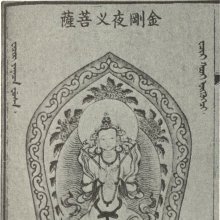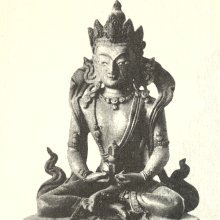Vajrayaksha, Vajrayakṣa, Vajra-yaksha: 4 definitions
Introduction:
Vajrayaksha means something in Buddhism, Pali. If you want to know the exact meaning, history, etymology or English translation of this term then check out the descriptions on this page. Add your comment or reference to a book if you want to contribute to this summary article.
The Sanskrit term Vajrayakṣa can be transliterated into English as Vajrayaksa or Vajrayaksha, using the IAST transliteration scheme (?).
Images (photo gallery)
In Buddhism
Tibetan Buddhism (Vajrayana or tantric Buddhism)
Source: Wisdom Library: MañjuśrīnāmasaṃgītiVajrayakṣa (वज्रयक्ष) is one of the sixteen samādhi deities appearing in the Vajradhātu-mahāmaṇḍala, according to the Nāmamantrārthāvalokinī v5.32-35. The Nāmamantrārthāvalokinī (literally, ‘an explanation of the nāma-mantras’) is a commentary (ṭīkā) on the 8th century Mañjuśrīnāmasaṃgīti.
Vajrayakṣa is a name of Mañjuśrī (the embodiement of non-dual knowledge) and, together with other names, forms the core essence of the Mañjuśrīnāmasaṃgīti. The Nāmamantrārthāvalokinī provides the practitioner a sādhana (‘meditative practice’) to turn these names into mantras. These mantras are chanted for the benefit of all beings, and then placed and contemplated in the Vajradhātu-mahāmaṇḍala, which is an extended version of the Vajradhātu-maṇḍala.
Source: archive.org: The Indian Buddhist IconographyVajrayakṣa (वज्रयक्ष) is another name for Ṭikkarāja: one of the ten deities of the quarters (Dikpāla) presiding over the Agni corner, commonly depicted in Buddhist Iconography, and mentioned in the 11th-century Niṣpannayogāvalī of Mahāpaṇḍita Abhayākara.—His Colour is blue; he has three faces and six arms.—Ṭakkirāja as the guardian of the Agni corner is very frequently referred to in the Niṣpannayogāvalī.—In the vajrahūṃkāra-maṇḍala his name is Vajrayakṣa. In the dharmadhātuvagīśvara-maṇḍala he is Vajrajvālānalārka.
Source: OSU Press: Cakrasamvara SamadhiVajrayakṣa (वज्रयक्ष) is the name of a deity [?] [i.e., oṃ vajrayakṣe hūṃ], according to the Kalaśa Pūjā [i.e., Kalasha Worship] ritual often performed in combination with the Cakrasaṃvara Samādhi, which refers to the primary pūjā and sādhanā practice of Newah Mahāyāna-Vajrayāna Buddhists in Nepal.

Tibetan Buddhism includes schools such as Nyingma, Kadampa, Kagyu and Gelug. Their primary canon of literature is divided in two broad categories: The Kangyur, which consists of Buddha’s words, and the Tengyur, which includes commentaries from various sources. Esotericism and tantra techniques (vajrayāna) are collected indepently.
General definition (in Buddhism)
Source: The Art of Asia: Who is Who in HeavenE. Vajrayaksa (a Vidyarajas) (Chinese: Chin kang cha; Japanese: Kongoyasha)See also (Relevant definitions)
Partial matches: Yaksha, Vajra.
Full-text: Takkiraja, Vajrajvalanalarka.
Relevant text
Search found 2 books and stories containing Vajrayaksha, Vajrayakṣa, Vajra-yaksha, Vajrayaksa, Vajra-yakṣa, Vajra-yaksa; (plurals include: Vajrayakshas, Vajrayakṣas, yakshas, Vajrayaksas, yakṣas, yaksas). You can also click to the full overview containing English textual excerpts. Below are direct links for the most relevant articles:
Guhyagarbha Tantra (with Commentary) (by Gyurme Dorje)
Text 11.17 (Commentary) < [Chapter 11 (Text and Commentary)]
Introduction 3.2.1: The preparatory ritual for the student’s entry < [Chapter 9 (Text And Commentary)]
Introduction 3.2.2: The Sequence of the actual Foundation of Empowerment < [Chapter 9 (Text And Commentary)]
A Dictionary Of Chinese Buddhist Terms (by William Edward Soothill)
Related products


